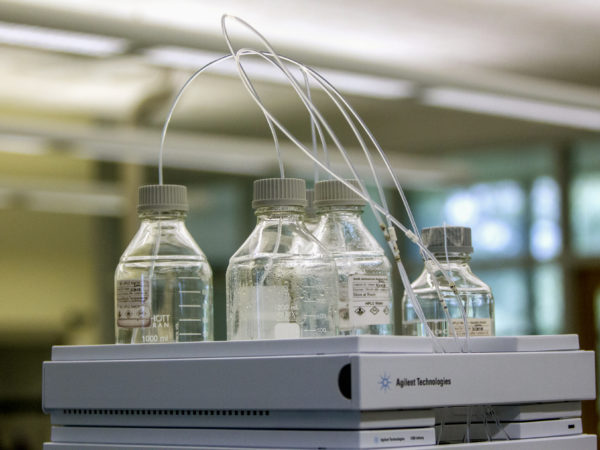
By Kelly House, Bridge Michigan
The Great Lakes News Collaborative includes Bridge Michigan; Circle of Blue; Great Lakes Now at Detroit Public Television; and Michigan Radio, Michigan’s NPR News Leader; who work together to bring audiences news and information about the impact of climate change, pollution, and aging infrastructure on the Great Lakes and drinking water. This independent journalism is supported by the Charles Stewart Mott Foundation. Find all the work HERE.
It wasn’t splashy news, but the state’s vow to remove lead from Benton Harbor homes could be life changing for residents of the lead-afflicted city, improving the health of children not yet born while boosting school graduation rates and lowering crime rates.
The Michigan Department of Health and Human Services on Thursday announced a goal to remove lead from every affected home in the city — a move that could protect thousands of people from sources of lead potentially more dangerous than the pipes that have taken center stage in the city’s more than three year water contamination crisis.
“We know from data, from science, that lead exposure generally happens through household related hazards,” said Carin Speidel, who manages the state health department’s lead services section. “It’s the paint, it’s the dust, it’s the soil and it’s the older plumbing.”
State officials aim to remove sources of lead from about 300 homes annually over the next several years, Speidel said. They have $9 million available this year to start the job.
Environmental and children’s health advocates say the unprecedented effort to rid an entire city of lead service lines and lead-based paint, faucet fixtures and contaminated soil will reap dividends for Benton Harbor residents and the broader public.
Lead is a toxic metal that can cause severe and permanent damage to children’s developing brains, from learning problems and stunted growth to lifelong behavioral issues.
Studies show spending money to prevent lead exposure saves society money in the long run by avoiding future costs associated with health care and educational needs, crime and lost productivity that result from lead poisoning. But at an average cost of $30,000 to $40,000 per home, ridding homes of lead is a financial impossibility for many Michiganders, particularly low-income residents.
At a statewide level, advocates say, Michigan’s available dollars for home lead abatement are not enough to quickly realize those gains, and policy gaps leave Michigan residents in the dark about lead hazards in their own homes.
“If (the Benton Harbor program) is successful, which we think it will be, then it’s time to make this the standard of care from the U.P. down to the Ohio border,” said Tina Wahl, environmental health program director with the Michigan Environmental Council.
In terms of potential public health gains, abating in-home lead hazards is arguably more crucial than removing lead service lines: In a 2017 study, the EPA estimated that soil and dust, which often come from chipping lead paint, are the biggest culprits in lead exposure among 1-year-olds. Food was next, followed by water.
Available data in Berrien County, where Benton Harbor is located, is not granular enough to identify the region’s leading sources of lead exposure, said Guy Miller, acting health officer for the county.
But in Benton Harbor, with its glut of aging homes built before the U.S. Government banned lead paint in 1978, many homes likely contain plenty of lead. Fifty-five percent of Benton Harbor homes were built before 1960. Statewide, the figure is 35.9 percent.
“That’s a significant exposure for children,” Miller said, “Especially because children are the ones crawling around on their hands and knees and putting things in their mouth. They like the texture. They like the feeling. And lead paint chips, unfortunately, taste sweet.”
Despite the risks from lead inside homes, the state and federal government have dedicated proportionally few public dollars to removing it as compared to the massive recent investments in lead service line removal.
Michigan’s just-passed $4.7 billion infrastructure spending plan includes $139 million for lead service line replacement statewide, plus another $45 million for Benton Harbor lead lines and $75 million for Detroit.
Combined state and federal funding to abate lead in Michigan homes, by comparison, has grown from about a million dollars a year in the 1990s to $35 million today. That’s enough to abate 900 homes this year, Seidel said. At that rate, “we’re looking at years and years and years of work” to eliminate in-home lead threats statewide.
The influx of money for Benton Harbor comes as regulators respond to a lead-in-water crisis that has entered its fourth year.
After community activists and environmental groups complained to the EPA last summer that state and local leaders weren’t taking the city’s water crisis seriously, Michigan lawmakers and the Whitmer administration rushed to eliminate the problem at its source. So far, construction crews have replaced 862 of the city’s estimated 4,363 lead service lines.
Overall, Michigan has seen vast improvements in childhood lead exposure rates in recent decades as bans on lead in paint (1978), service lines (1986) and gasoline (1996) tamped down key sources of exposure. The percentage of children with elevated blood lead levels has fallen from nearly a third in 2000 to just 2.4 percent in 2020.
But hot spots remain in places with older housing stock, where residents are more likely to live in homes with lead paint and draw their water from lead-containing service lines. Urban homes often also have lingering soil contamination from construction, industry and the legacy of leaded gasoline.
Michigan’s hot spots include Grand Rapids, Detroit, Saginaw, and more rural places like the Albion and White Pigeon areas.
Lead levels falling but still high in some areas
For over two decades, the percentage of children under 6 who have elevated levels of lead in their blood has dropped dramatically in Michigan, mainly as a result of a ban on lead paint and the remediation of lead paint in older homes. In 2000, nearly a third of children under 6 who were tested had elevated lead level; the rate dropped to 2.5 percent in 2020. But children in a number of ZIP Codes in Michigan still suffer from the ravages of the metal which can impact learning and behavior. You can use this map to see the percent of children with elevated lead levels in your ZIP Code in 2020 and from 2016. To use the search function, put the name of the municipality, state and ZIP. For instance: “Detroit, MI 48204.”
*Note: In cases where there are between 1 and 5 children with elevated lead levels in a ZIP Code, the state suppresses the data for privacy reasons.
Source: Michigan Department of Health and Human Services
Environmental and public health advocates hailed Benton Harbor’s abatement program as a win-win for residents in the high-poverty city. Replacing drafty, lead-tainted windows and siding eliminates health hazards while reducing home energy bills and raising property values.
“It improves the housing stock for everyone,” Wahl said.
She wants the type of pre-emptive lead abatement being offered in Benton Harbor to be the norm across the state. As it stands, she said, most lead abatement is typically limited to the poorest residents, and often only after elevated lead is detected in a child’s blood.
State policy changes could help more homeowners take action on their own, Wahl said. Her group is advocating for a bill sponsored by Rep. Stephanie Young, D-Detroit, that would require lead inspections before the sale or transfer of property of a home built before 1978.
“If there was one policy, if I was king for a day, that would be the one.” she said of the bill, which is part of a package of proposals targeting lead.
But the bill faces opposition from real estate industry advocates, who note that federal law already requires disclosure of likely lead hazards in any home built before 1978.
“You’re really creating an inspection for something we already know most likely already exists in the home,” said Brad Ward, vice president of public policy and legal affairs with Michigan Realtors.
Miller, the Berrien County health officer, has other thoughts on how the state could better protect residents from lead in homes: Elevated lead levels often crop up among renters who have little control over living conditions, and landlords often have little incentive to make improvements.
“Is the solution in rental agreements?” he said. “Some way to enforce that with policy and put (the onus) back on the landlord to say, hey, you need to make sure this home was tested for lead.”
In Benton Harbor, an activist who raised the alarm about the city’s lead problems hailed the abatement program as a welcome development. But he noted it won’t fix the damage already done to residents who may have spent years drinking tainted water.
“You can remove the lead from homes,” said Rev. Edward Pinkney, leader of the Benton Harbor Community Water Council. “But you can’t remove the effects of lead from someone’s body.”
Catch more news at Great Lakes Now:
Substantive change will require a ‘massive culture shift’ in federal, state and local agencies
Benton Harbor residents should keep drinking bottled water, but EPA says filters work on lead
Featured image: Lead pipes get far more media attention in Michigan, home to water crises in both Flint and Benton Harbor. But nationwide, in-home hazards like lead paint are a more common source of childhood lead exposure. (Bridge file photo)




